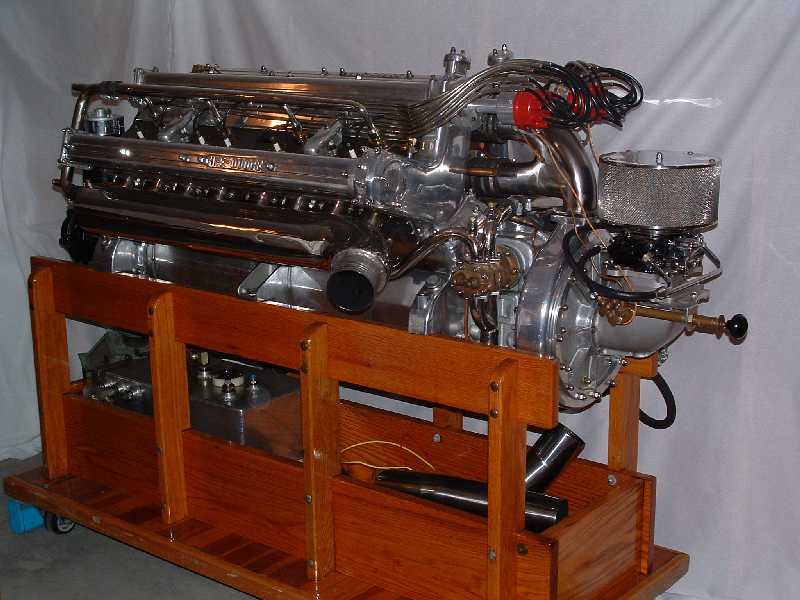
1934 27’ Hacker Gold Cup Race Boat
1927 Miller V-16 Supercharged
Gold Cup Engine
2001 Marine Power S-500
X V-8 Engine
Custom Show Trailer, Trailering
Cover
Documentation
- One of seven remaining Gold Cup boats that raced in the 1920s and 1930s, complete with an original Gold Cup engine.
- A fully documented history, Ethyl-Ruth IV/Chloe has been on the water most of her life and proven to be a fast, stable hull under a variety of conditions.
- Your choice --boat is set up to run with either original Miller V-16 or modern high performance V-8 engine.
- Authentically restored by Muller Boatworks, the boat has a new traditional style bottom, 95% original topsides, and is in first place, show condition.
- Ready to race in the upcoming 100th Anniversary Gold Cup season.

Dodge-Miller V-16 Gold Cup Racing Engine
V-16 Miller Gold Cup Centrifugally
Supercharged Engine
Year: 1927
Designer: Harry Miller
Design: Aluminum alloy,
60 degree double-overhead camshaft
Displacement: 620
cubic inch 1927 Horsepower: 420 hp.
732 cubic inch with
blower in 1935 Horsepower: 650 -1000 hp.
Original magnetos, gear box and spare engine parts included
Documentation Included:
Copy of 1933 Harry Miller
16-cyl. engine specifications, copies of correspondence from John L. Hacker,
J. Paul Miller, Al MacKenzie and Tom Frauenheim; Harold Rivard restoration
log; 1934 Rosenfeld photographs of boat and vintage engine photographs;
original 1934 Lake George Regatta program.
History:
Harry Miller, of Indianapolis
fame, was the foremost race engine builder of the day. In 1927 he
built three 620 cubic inch V-16 engines for Gold Cup class speedboat racing.
Dr. S. C. Smith ordered one for
Baby Chic, a Gold Cup built by Chris
Smith; Harold Greening put his Miller in a Ditchburn designed Rainbow
VI; and James A. Talbot had his Miller supercharged and installed in
Miss
Los Angles to compete for the Harmsworth Trophy. Although the
history of each engine is unclear; period racing reviews and articles provide
a good record of two of the Miller V-16’s which ran head to head in many
races through the 1930s and into the1940s.
In the 1930, John D. Shibe, of Philadelphia obtained one of the Miller 16’s for his Gold Cup Miss Philadelphia and raced it for two years. The boat did not perform well, so Shibe moved on to his next project. The Gold Cup stepped-bottom race boat Ethyl Ruth IV was designed and built by John L. Hacker for the Miller 16. The boat performed well, but the engine proved difficult and both were retired after the 1934 races. After Shibe’s death in 1937, the engine was sold to Zalmon Simmons, who had the engine rebuilt by Charles Zumbach for My Sin. Reliable and fast, this boat/motor combination won the Gold Cup in 1939, 1941 and again in 1946 when it raced as Tempo VI with Guy Lombardo. The last record of this engine dates 1949 when it’s crankshaft broke during the time trials in Joe Van Blercks’ boat Aljo/Gray Goose. Rumors claim that the winning Zumbach Miller is in a private collection, others suggest that it went to the Staten Island landfill.
Horace E. Dodge acquired his Miller in the early 1930s and installed it in Impshi, one of his Gold Cup racers. It ran it in the boat for many years under a variety of names including Delphine VI, Hornet and Ethyl-Ruth III.
Around 1935, the V-16 threw a rod, damaging the crankcase beyond repair. A major rebuild was undertaken at the Horace Dodge Developmental Laboratory involving three of the greatest names in engine design of the period: Harry Miller, car and engine builder, J. Paul Miller, supercharger expert, and Leo Goosen, engine designer for Harry Miller.
- Goosen designed a new improved crankcase following innovations he had used in the 1113 CID Gar Wood/ Miller V-16 from 1931. This new crankcase had massive main bearing caps which eliminated the need for inspection plates on the sides that weakened the crankcase. Assembly was more difficult, but this design vastly improved crankcase stiffness for the demands of Gold Cup racing.
- A new set of 4 bolt connecting rods was designed and built incorporating an accurate placement of the link pin location, which corrected an error in the original design.
- Large bore blocks were made up with the Miller-Schofield 183 bore size moving the displacement of the 620 V-16 to the 12 Liter Gold Cup Rules limitation of 723 CID.
- J. Paul Miller’s design for a centrifugal supercharger was used to build a 7:1 geared up blower turning an 8” diameter forged impeller a speeds exceeding 35,000 rpm.
- Power output of the engine was claimed to be 1075 hp. with 15 psi boost at 5,000.
Mark Mason acquired the Miller V-16 from the Dodge estate in 1980 and had it extensively rebuilt by noted Connecticut engine restorer, Harold W. Rivard. A new crankshaft and all new supercharger gears, pistons and many other parts were made during the restoration.
In 1994, David L. Coffin,
new owner of Ethyl Ruth IV purchased the engine and had race mechanic
Douglas Bindrim continue the project, and prepare the engine for installation
in his newly restored Ethyl Ruth IV. The last remaining Miller
16 has been running at vintage race boat regattas since.